Applying sunscreen daily is a simple but highly beneficial step in your skincare routine that can protect you from the formation of the harmful free radicals that can basically cause all hell on your skin.
However, choosing the right one for you can be crazy challenging, especially when a new one seems to be popping up on the market every other day.
To simplify things a little, we have divided sunscreens into two different categories:
- physical sunscreen
- chemical sunscreen
There is a big debate about which type of sunscreen is the best, so in this article, I will explain the main differences between chemical and physical sunscreens and show you how to choose the right one for you.
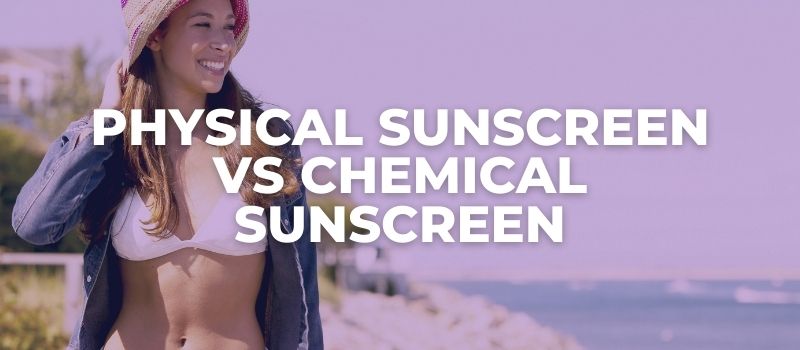
What Are Physical Sunscreens?
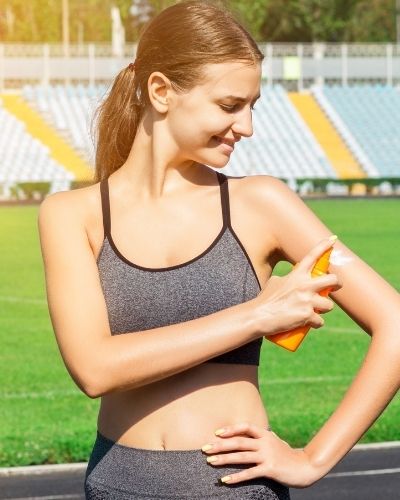
Physical or mineral sunscreens protect your skin by physically blocking and deflecting UV light away (hence the name) and to do so they have to contain two ingredients:
Physical sunscreens do not penetrate your skin and do not need time to start acting as a shield. Therefore they start protecting your skin as soon as you apply them on.
Due to the gentle ingredients they contain, physical sunscreens are less likely to irritate sensitive skins and have longer shelf life than chemical formulas.
Ingredients in Physical Sunscreens
The ingredients, as we said before are simple, but let’s elaborate a little deeper on what these do for your skin.
Zinc Oxide is an important nutritious mineral found in our body that protects the immune system and metabolism by fighting off harmful bacteria.
While this superstar mineral is important to keep you healthy by reducing illnesses, preventing colds, and healing wounds, it has also been studied for other skin concerns too.
It is actually one of the most studied elements for acne, minor burns, severely chapped skin, irritations, as well as diaper rash.
This tells us that zinc oxide is, in fact, safe to be used on children, and if you have been worrying about which sunscreen to opt for when it comes to protecting your child’s skin against the sun, physical sunscreen that contains zinc may be the best choice for you.
However, if you are concerned about skin aging, zinc may play an important role for you too.
It is a powerful antioxidant and a key part of your skin’s defense squad. This mineral fights the formation of damaging free radicals and decreases oxidative stress, making it the best possible ingredient in sunscreen.
Titanium Dioxide is the second active ingredient in physical sunscreens and it works as a UV filtering ingredient in these products.
That means that it helps to protect your skin by blocking the absorption of the sun’s ultraviolet light that can cause sunburn.
While many people may have an issue with the harsh-sounding name of this ingredient, titanium dioxide has been included in the FDA’s list of acceptable active ingredients in sunscreen products.
According to the FDA, titanium dioxide as an active ingredient in your physical sunscreen, protects your skin from the UV rays and is safe to use.
Environmental Safety
Besides being an extremely protective and non-toxic option for your skin, physical sunscreens are also reef-safe.
This means they won’t negatively impact marine ecology if you go swimming after applying them on your face.
If snorkeling is the perfect description of how you want to spend your days while on vacation, be sure you are not doing any harm to coral reefs.
Physical Sunscreen Pros:
Physical sunscreens offer protection against both UVA and UVB rays and are formulated to offer broad-spectrum protection.
They also protect you from the sun as soon as you apply them on and they sit on top of your skin as a shield with no waiting needed before heading out.
They tend to last longer than chemical sunscreen when exposed to direct UV light.
While it is still advisable that you reapply your sunscreen every couple of hours if you are spending the day outside, you can probably even get away from doing that unless you are directly exposed to the sun.
Physical sunscreens are easily tolerated by sensitive skin types due to their ingredients. They are less likely to cause a stinging sensation or irritation on the skin.
It is extremely recommendable to opt for a physical sunscreen if you happen to be prone to rosacea or redness that is easily activated by heat as they deflect the heat given off by the sun along with UV rays.
Physical sunscreens are less likely to clog your pores, which is also something you should consider if you have blemish-prone skin.
But, they can be very moisturizing which makes them excellent for dry skin types, but less so for oily skins.
Lastly, due to the particular formulation, physical sunscreens have a longer shelf life than chemical sunscreens.
Physical Sunscreen Cons:
Although they might sound perfect from what you read above, there is hardly such thing in this world, so here are some cons to consider when hunting for a good sunscreen:
Physical sunscreens can be difficult to fully blend into the skin due to the white cast they leave behind. This may make some formulas incompatible with deeper skin tones.
This can also make them look a little chalky and opaque for daily use under your makeup.
Physical sunscreens may create an occlusive film, which results in increased perspiration during physical activities. This can contribute to your physical sunscreen to rub off, sweat off, and be rinsed off easily.
Some people have found it annoying that white drips sometimes show on the skin when sweating.
They tend to be thicker, which will require more effort to rub in, and while the extra moisturizing layer may be excellent for dry skins, oilier skin types may find physical sunscreens a bit too heavy.
Lastly, physical sunscreens won’t offer full protection unless you apply a generous amount and do so accurately. This is because UV light can get through gaps in the sunscreen molecules and easily penetrate the skin.
My Top Physical Sunscreen Recommendations
Here are some of my favorite physical sunscreens:
Derma E – Natural Mineral Sunscreen Broad Spectrum SPF 30
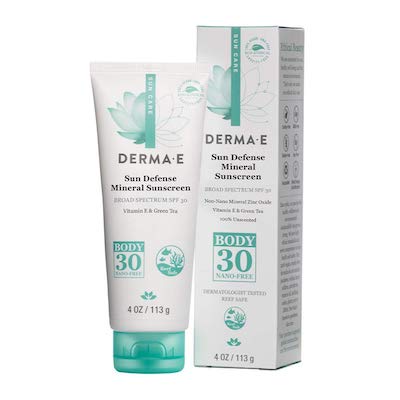
Derma-E is a cruelty-free brand designed to be completely effective with great product formulations carefully selected from high-quality origins.
Their natural mineral sunscreen offers a broad spectrum of SPF 30 that can be used by adults and children for full-time protection from damaging sun rays.
Shiseido – Anessa Perfect UV Sunscreen Mild Milk SPF 50+ PA++++
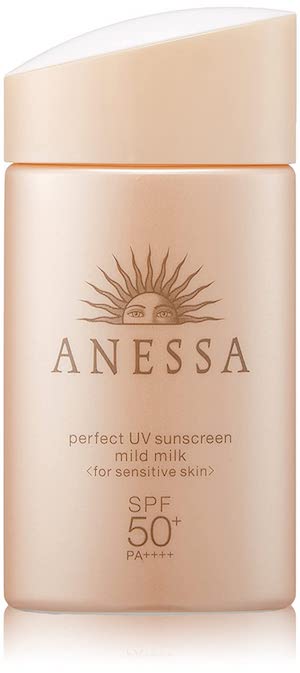
This gentle sunscreen milk offers high UV protection, and it is tailored for adults and children’s sensitive skin.
It uses Anessa’s signature Aqua booster technology which reacts compatibly with the minerals existing in sweat and water to create an even more uniform protective veil that will boost your UV protection by 20%.
It is both alcohol and fragrance-free and will leave your skin feeling comfortable and silky smooth.
MISSHA – All-Around Safe Block Essence Sun Milk SPF50+ PA+++
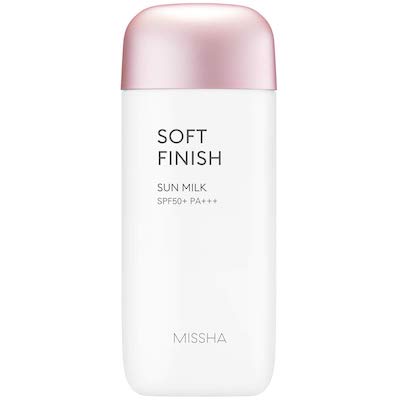
I’m going to be honest with you and admit that the first time I’ve purchased this sun protection essence was purely because I found the packaging extremely pleasing to the eyes.
Turns out it worked great for my oily but also dehydrated and coarse skin as it simply rehydrated it back to life with an added protection of SPF 50.
It made my skin feel cooled and fresh and I solemnly swear I will forever be keeping one of these in my handbag.
Innisfree – Moist Winter Barrier Sunscreen SPF 50
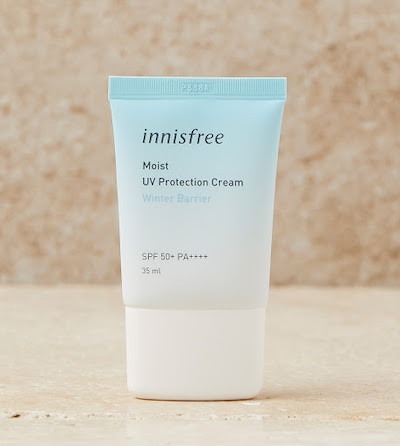
It is a creamy and soft sunscreen that I always reach for during the winter days.
It is designed to hydrate and lock moisture into the skin due to the proficient blend of five types of hyaluronic acid.
This lightweight moisturizer/sunscreen is the perfect asset for winter days when looking for that much-needed UVA protection and hydration.
What Are Chemical Sunscreens?
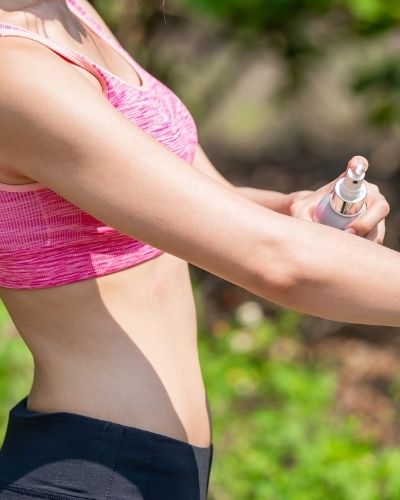
Chemical sunscreens are, simply put, products that contain chemicals. These are more common and work in a slightly different way than physical sunscreens.
Instead of physically shielding you from the sun, they absorb the UV light, then release it as heat (or infrared rays) as a result of a chemical reaction of changing the electromagnetic radiation effect.
Although they have been doomed as harmful and cancer-causing chemicals, the truth is that we really shouldn’t stop using sunscreen to prevent cancer and premature aging.
It sounds silly and counteractive, so let’s not go there.
Ingredients in Chemical Sunscreens
Sunscreens include different types of active ingredients than physical sunscreens and they also contain chemicals.
We’re talking things like:
Octocrylene is an oil-soluble agent that protects the skin from the burning (UVB) rays mostly and somewhat in the aging (UVA) range.
However, its protection is deemed weak on its own, but it is a considerably photostable chemical; therefore it is most often used to stabilize other photo-unstable UV filters such as Avobenzone.
It is also used to improve the water resistance of chemical sunscreens, which chemical sunscreens are really known for.
While its safety profile is generally good, some people have shown signs of allergies after applying chemical sunscreens, which can be directly linked to Octocrylene.
Because chemical sunscreens can sometimes cause irritations and sensitivity, it is generally not recommendable for children to use them.
Avobenzone is a dibenzoyl methane derivative and an oil-soluble ingredient that has the ability to absorb UV light over a wide range of wavelengths.
It is a blocker that protects against both UVA and UVB lights and it is included in a wide range of chemical sunscreens.
However, Avobenzone is sensitive to light so, to increase its stability and duration of action, photo stabilizers such as Octocrylene (above) have to be added in the product.
Octinoxate seems to be the most problematic ingredient that makes many people opposed to using chemical sunscreens.
It is an oil-soluble ingredient that can be absorbed rapidly through the skin and as a result of this can be found in human urine, blood, and even breast milk.
This also indicates that we are systemically exposed to this compound even if we are not using a chemical sunscreen.
Octinoxate is an ingredient that is often found in cosmetic products such as shampoos, lipstick, nail polish, and even creams under different names.
If you are looking to completely eliminate this ingredient from your cosmetics, read the ingredient list on the label and search for Octinoxate, o Methoxycinnamate (OMC), Parsol, Parsol MCX, Parsol MOX, Escalol, 2-Ethylhexyl P-Methoxycinnamate.
It is formulated by combining Methoxycinnamic acid and 2-Ethylhexanol compounds that, when mixed together, form a clear liquid that does not dissolve in water.
In chemical sunscreens, it is used as a UV filter to protect the products from degrading when exposed to the sun.
The main health concerns from this ingredient are thought to be endocrine disruption, reproductive and developmental toxicity as well as organ system toxicity.
However, this ingredient is for now approved for use in cosmetics worldwide and further studies are still to be made to determine if it’s really toxic for us to use.
Environmental Safety
In a 2016 study, a team of international scientists found that common chemicals used in many chemical sunscreen lotions can be highly toxic to juvenile corals and other marine life.
Oxybenzone or BP-3 is found in many cosmetic products worldwide and serves as a protection against UV light.
The compound has been found entering the environment both through wastewater effluent and directly from swimmers wearing sunscreens.
The study showed four major toxic effects in developing coral:
- increased susceptibility to bleaching
- DNA damage (genotoxicity)
- abnormal skeleton growth
- deformities of baby coral
Therefore, chemical sunscreens may be a better option to use daily under makeup while it is probably best to keep them away from marine life.
Chemical Sunscreen Pros:
Chemical sunscreens are thinner and lighter; therefore they happen to spread more easily on the skin, making them more suitable for daily wear under your makeup.
Unlike physical sunscreens, less is needed to protect the skin because of their high spreadability. There is no risk of remaining gaps between the sunscreen molecules after application.
The light formula won’t leave an oily, heavy, or white film, and it is easier to add additional treatment ingredients.
It is great for both dry and oily skin types as it is lightweight and hydrating.
Chemical Sunscreen Cons:
Chemical sunscreens can often be irritating to sensitive skin types and are generally not recommended for children.
It has been theorized that it is possible to cause an increase in existing brown spots and discoloration patches due to the chemical reaction that increases skin temperature.
It often requires you to wait up to 20 minutes after application to become effective and create a protective film over the skin.
The protection it offers gets soaked in by the skin pretty quickly when direct sun exposure is present, so reapplication must be more frequent with some products suggesting reapplication every 45 minutes while outside.
It has an increased chance of irritating rosacea-prone skin types because it changes UV rays into infrared heat, exacerbating flushing.
The chemical ingredients Oxybenzone and Octynoxate have been banned in Hawaii for posing a risk to coral reefs when worn by swimmers.
It can cause stinging and irritation if it drips into the eyes through sweating.
My Top Chemical Sunscreens Recommendations
If you would like to switch things up a little and give chemical sunscreens a fair trial, I have some great recommendations for you.
Here are some of them:
Kao – Biore UV Aqua Rich Watery Essence SPF 50+ PA++++
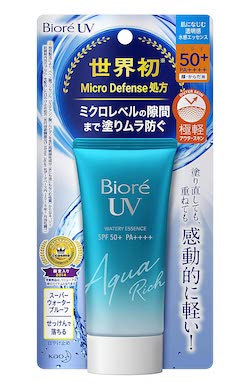
Watch out, everyone! An updated version of Biore’s most loved UV Aqua Rich Watery Gel is powered by the innovative Micro Defense formula that actually prevents uneven application.
Sticky feeling is something I am always struggling with products and it’s something that either makes it or breaks it for me.
Seriously though, I cannot love a product if it leaves a sticky feeling on my face as I will constantly feel like a magnet for dirt and bacteria.
This colorless essence forms an invisible water-resistant shield on the skin without feeling sticky and leaves your skin feeling fresh and hydrated due to the hyaluronic acid, royal jelly, and other moisturizing ingredients for maximum comfort and moisture.
Shiseido – Anessa Essence UV Sunscreen Mild Milk For Sensitive Skin SPF 35 PA++++
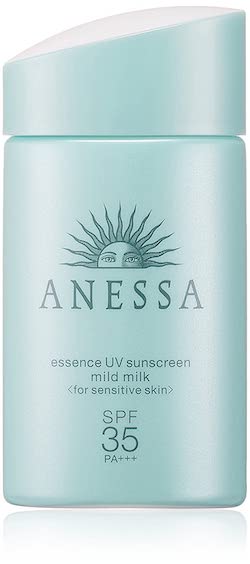
This lightweight formula contains collagen complex that moisturizes the skin and lately, I have been really loving anti-aging products like moisturizers that encourage collagen production and retinol. Hence, I like to opt for sunscreen with added anti-aging benefits like this one.
It is completely free from artificial fragrances, colorings, alcohol, and mineral oils and can be used on the face and body, though my preference is packing as much as I can on my face and neck.
MISSHA – All Around Safe Block Aqua Sun Gel SPF50+ PA++++

This sunscreen comes in a lightweight and non-sticky gel formulation and it feels like a breath of fresh air on my oily, dehydrated, and extremely sensitive skin.
You are bound to love this simple hydrating gel if any of those three describes your skin type.
It contains ice plant, glacial water, and thanaka extracts to refresh, moisturize, reduce blemishes on your skin, and of course, protect you from the skin’s number one enemy – the sun.
Why Should We Apply Sunscreen?
There are several good reasons to be diligent with your sunscreen application and I am going to list the most important one first:
It Lowers Your Risk Of Skin Cancer: Skin cancer is the most common form of cancer and yes, it is can be fatal. By applying sunscreen each day, you really cut your risk of contracting skin cancers in half.
It Protects Your Skin from Harmful UV Rays: The depletion of the ozone layer has increased our risk of sun damage from harmful UV rays. You know what blocks these harmful rays, right? You got it. Sunscreen is the product for you.
It Prevents Premature Aging of the Skin: Sun damage from UV rays causes photoaging of the skin, which is characterized by a coarse, leathery look; discoloration, uneven patches of pigmentation, and a breakdown of collagen, which essentially contributes to the appearance of fine lines, wrinkles, and sagging skin. Imagine you could prevent all this by just applying that extra layer of sunscreen in the morning.
Which SPF Should You Use?
It was once widely believed that an SPF of 15 offered sufficient UV protection under most conditions.
However, over the years that school of thought has changed.
If you have read any of my previous articles, you probably know that I cringe whenever I hear someone using anything lower than SPF 30.
It is ideal to select a sunscreen that blocks enough UV rays to adequately protect your skin type.
If you have very fair or sensitive skin, a history of skin cancer, or take photo-sensitizing medication such as Isotretinoin it is of utmost importance to use high SPF.
It is also important to remember that high-number SPF does not allow you to spend additional time outdoors without reapplication.
So, if you crave a nice day by the beach, always remember that you are never fully protected by the sun.

My name is Simone and I am a certified skin specialist. I created this website to teach my readers how to take great care of their skin and I also like to occasionally share my honest opinions on skincare products I’ve tried. You can learn more about me here.
